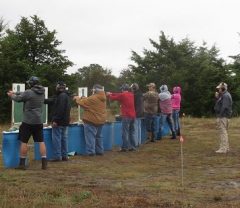by Sandy Keathley
Many people think that shooting a pistol accurately is not a complicated thing; just point and pull the trigger, like throwing a baseball. This has no doubt been exacerbated by what we see on TV. My favorite typical scene is where the good cop shuts down the power to a building by shooting a power line suspended from a tower 75 feet off the ground. One handed. Really?
In reality, shooting involves a complex mix of skills, in balance with each other. None of them are difficult, and can be learned in a few minutes, but managing that mix takes practice. Anything that upsets that delicate mix to impart even the slightest misalignment of the center axis of the bore to the target will cause the shot to miss. Due to the geometry involved, a slight miss at a short distance becomes a much larger miss at longer distances.
The factors most often mentioned that affect the shot are trigger-work, sight-alignment, and anticipation of recoil, but breathing can also have a part. Rifle shooters tend to be more aware of this than pistol shooters, because they have the rifle against their shoulder, and the shoulder moves during breathing, but it is a factor for pistols as well.
Holding your breath is actually not the best approach; it tends to cause tension and stress, especially over multiple shots. A better approach is to “stop” or “pause” the breathing process for about 2 seconds, then resume after the shot. There are two places in the breathing cycle where this happens naturally: at the top (after complete inhalation), and at the bottom (after complete exhalation). Some people like to take advantage of these natural pauses to take the shot. I would tend to use the bottom pause, as there is more relaxation there (and more tension at the top). Another idea is to wait until shortly after the bottom of the cycle, when you have inhaled about 1/3 of your capacity, then pause.
Which way you manage this is a very individual thing, but doing something about it will give you a more stable platform from which to shoot, and better accuracy.


